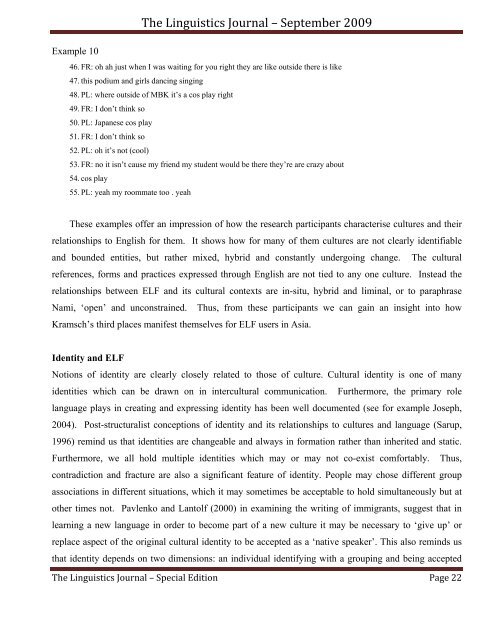The Linguistics Journal September 2009 Special Edition Language
The Linguistics Journal September 2009 Special Edition Language
The Linguistics Journal September 2009 Special Edition Language
You also want an ePaper? Increase the reach of your titles
YUMPU automatically turns print PDFs into web optimized ePapers that Google loves.
Example 10<br />
<strong>The</strong> <strong>Linguistics</strong> <strong>Journal</strong> – <strong>September</strong> <strong>2009</strong><br />
46. FR: oh ah just when I was waiting for you right they are like outside there is like<br />
47. this podium and girls dancing singing<br />
48. PL: where outside of MBK it’s a cos play right<br />
49. FR: I don’t think so<br />
50. PL: Japanese cos play<br />
51. FR: I don’t think so<br />
52. PL: oh it’s not (cool)<br />
53. FR: no it isn’t cause my friend my student would be there they’re are crazy about<br />
54. cos play<br />
55. PL: yeah my roommate too . yeah<br />
<strong>The</strong>se examples offer an impression of how the research participants characterise cultures and their<br />
relationships to English for them. It shows how for many of them cultures are not clearly identifiable<br />
and bounded entities, but rather mixed, hybrid and constantly undergoing change. <strong>The</strong> cultural<br />
references, forms and practices expressed through English are not tied to any one culture. Instead the<br />
relationships between ELF and its cultural contexts are in-situ, hybrid and liminal, or to paraphrase<br />
Nami, ‘open’ and unconstrained. Thus, from these participants we can gain an insight into how<br />
Kramsch’s third places manifest themselves for ELF users in Asia.<br />
Identity and ELF<br />
Notions of identity are clearly closely related to those of culture. Cultural identity is one of many<br />
identities which can be drawn on in intercultural communication. Furthermore, the primary role<br />
language plays in creating and expressing identity has been well documented (see for example Joseph,<br />
2004). Post-structuralist conceptions of identity and its relationships to cultures and language (Sarup,<br />
1996) remind us that identities are changeable and always in formation rather than inherited and static.<br />
Furthermore, we all hold multiple identities which may or may not co-exist comfortably. Thus,<br />
contradiction and fracture are also a significant feature of identity. People may chose different group<br />
associations in different situations, which it may sometimes be acceptable to hold simultaneously but at<br />
other times not. Pavlenko and Lantolf (2000) in examining the writing of immigrants, suggest that in<br />
learning a new language in order to become part of a new culture it may be necessary to ‘give up’ or<br />
replace aspect of the original cultural identity to be accepted as a ‘native speaker’. This also reminds us<br />
that identity depends on two dimensions: an individual identifying with a grouping and being accepted<br />
<strong>The</strong> <strong>Linguistics</strong> <strong>Journal</strong> – <strong>Special</strong> <strong>Edition</strong> Page 22


